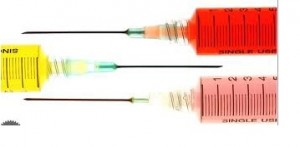 Another guest article from Jamie Bridge this week. This time he’s writing about some of the work of researcher Dr. William Zule, looking into how the type of syringe someone uses may have an inpact on their risk of getting the HIV virus. I have had this article a few weeks but it was embargoed until the AIDS2010 conference started as its finding are being presented there.
Another guest article from Jamie Bridge this week. This time he’s writing about some of the work of researcher Dr. William Zule, looking into how the type of syringe someone uses may have an inpact on their risk of getting the HIV virus. I have had this article a few weeks but it was embargoed until the AIDS2010 conference started as its finding are being presented there.
How syringe type effects HIV risk
New research being presented this week at the International AIDS Conference in Vienna has made a strong link between different types of syringe and levels of HIV transmission through sharing.
Every needle-syringe, when the plunger is fully depressed, retains some fluid or blood in what is termed “dead-space”. Some syringe designs have more of this “dead space” than others – especially those with detachable needles. Depending on the design, some syringes can retain 84 microlitres of fluid. This is a very, very small amount – but other syringe designs can retain as little as 2 microlitres.
So the hypothesis is simple: if you share a syringe with higher “dead-space”, then there will be more blood retained in the syringe and you will be more likely to become infected with blood-borne viruses. If you share a low “dead space” syringe, you are still putting yourself at risk – but perhaps less so, as there is less blood retained when the plunger is fully down.
Previous modelling work by Dr William Zule and colleagues in the USA tried to quantify what this could mean in the real world. The results suggested that injection-related HIV epidemics might not occur when most (95% or more) of injectors use syringes with low “dead space”. If everyone uses higher “dead space” syringes, then HIV prevalence can reach 50% among injectors in just seventeen years. When just one in ten sharing events involve high “dead space” syringes, then HIV prevalence can stabilise.
The findings, albeit theoretical, have clear implications for harm reduction programs. However, in Vienna, the research has been taken to the next level. Data from multi-year HIV prevalence studies were gathered from 35 cities in 20 countries, and local needle exchange workers were contacted to find out what types of syringe were mainly used.
In cities where high “dead space” syringes were mainly used, the average HIV prevalence among injectors was 32.6% (and went up as high as 73%). In cities where low “dead space” syringes were mainly used, the average was just 1.4%. When the data were analysed, the type of syringe was the only factor closely associated with this pattern in HIV.
More research needs to be done on this topic, and expect to hear a lot more about this in the future – this is an important finding which could have a big impact on harm reduction and the advice given to injectors. Of course, the biggest message is that ALL needle-syringe sharing is a risk. However, if we could reduce HIV transmission simply by providing one kind of syringe over another, then this is something that must be rolled out as soon as possible. Do you know what kind of syringe your local exchange supplies?
A big thank you to Dr William Zule for sharing this research.
Jamie Bridge, MSc, currently works in the Technical Publications and Learning Team of the Global Fund to Fight AIDS, Tuberculosis and Malaria. Before moving to Geneva in 2010, he worked for the International Harm Reduction Association in London, coordinating the international harm reduction conferences. Before that, he also worked in a needle and syringe program in Bedford. Jamie also works voluntarily with UKHRA and the NNEF.
——-